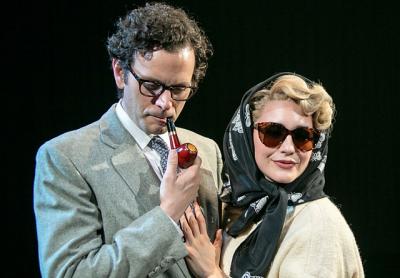Legends Made Human Onstage at Bay Street

A new summer season at Bay Street Theater in Sag Harbor is off to a smashing start with “Fellow Travelers,” an engrossing and beautifully acted new drama by Jack Canfora that runs through June 17.
“Fellow Travelers” chronicles the conflicted friendship of two titans from the golden age of American theater — the writer Arthur Miller and the director Elia Kazan. During much of the 1950s and early ’60s, Miller’s and Kazan’s lives seemed dramatically intertwined. It began with Kazan directing Miller’s first two breakout plays, “All My Sons” and “Death of a Salesman.” Later, the two men would both be called before the House Un-American Activities Committee, and then each had affairs with Marilyn Monroe. (She and Miller were married in 1956.)
With the play’s punchy, often vulgar dialogue, Mr. Canfora wrings genuine conflict and emotion from his two talented and driven characters.
It begins in 1951 with Miller and Kazan on a train to Hollywood, where they are shopping Miller’s screenplay “The Hook,” about Brooklyn longshoremen. It’s here that all the later conflicts begin to smolder: Miller begins his infatuation with the then-unknown actress Marilyn Monroe, even as she and Kazan are having an affair; and when an envoy from the Un-American Activities Committee urges Miller to make changes to his script, the playwright refuses, even as Kazan cajoles him to compromise. (The project is scrapped, though Kazan would later cannibalize parts of “The Hook” into a little something called “On the Waterfront.”)
You would be hard pressed to believe that “Fellow Travelers” is a new play, since nearly everything in this production seems to hit its target. The set design is clever and unobtrusive, the writing both lean and muscular, and the actors, as directed by Michael Wilson, are stunningly good. Wayne Alan Wilcox not only bears an uncanny resemblance to Arthur Miller, but perfectly captures Miller’s scholarly reserve and diffident speech patterns. And though physically Vince Nappo is hardly a dead ringer for Elia Kazan, he does well in embodying the Greek immigrant’s pugnacity, a man who is a walking bundle of attitude and appetites.
Nearly stealing the play, however, is Mark Blum as Harry Cohn, the head of Columbia Pictures. Mr. Blum takes what can often be a cliché — the foul-mouthed movie producer — and under-chews the scenery with just enough discretion to make Cohn both human and wretched at the same time. With just the right shadings of bluster and amity, Mr. Blum makes fresh a role that in the hands of a lesser actor could be a one-note bore.
But in a production with so many excellent performances, it is no small compliment to say that Rachel Spencer Hewitt, as Marilyn, makes the play her own. So iconic is Monroe — and so caricatured in popular culture — that there may be no more treacherous role for an actress to play. Just on sheer guts, one must tip his hat to Ms. Hewitt for trying.
But the actress does much more than that, with a portrayal that captures both the iconic Marilyn and the tender and in nocent woman she most likely hid from the world. In “Fellow Travelers,” we get a Marilyn on the cusp, both world-weary and yet still hopeful about her career and the possibility of love. After her divorce from Miller, she would never be quite the same.
The history of Elia Kazan and Arthur Miller at the committee hearings is well known: Kazan eventually named names to the committee and went on to a fruitful career, while Miller refused to talk and escaped prison only on a technicality. The legend — like most legends — rests on hyperbole: Kazan was a rat while Miller was an uncompromising saint.
Thankfully, Mr. Canfora’s writing transcends these clichés. While the play is hard on Kazan, there is an important exchange in which Miller sympathizes with the director’s decision to betray his friends; for Kazan not to work, Miller states, would have been like a self-imposed “death sentence.” While the play hardly absolves Kazan, there is at least the desire to understand him.
And just when Miller’s saintly posturing grows tiresome, Mr. Canfora has both Kazan and Harry Cohn take pithy potshots at the playwright’s sanctimony.
But it’s Marilyn Monroe who, even in death at play’s end, gets the last word. Just as her image bedeviled millions of filmgoers (and continues to do so), so did she loom in the minds of Miller and Kazan; neither ever really got over her. Thanks to a great performance by Ms. Hewitt and the tender writing of Mr. Canfora, she ultimately dominates “Fellow Travelers” as well
